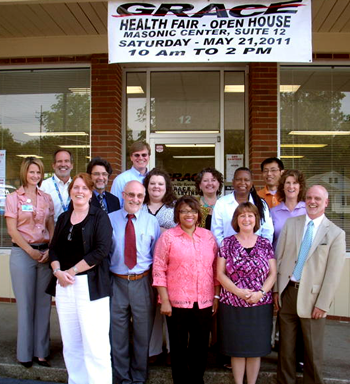Nation's largest chlorine gas disaster leads to NIH study aimed at helping Graniteville, area communities

The GRACE Study staff is pictured at their new office in Graniteville: Susan Whiddon, Randy Baker, Kathi Clark, Andrew Mazzoli, Wilfried Karmaus, Erik Svendsen, Becky Painter, Louisiana Sanders, Margaret Bridges, Edie Corley-Stone, Tina Bevington, Bo Cai, Deborah Salzberg, and John Vena.
A powerful new documentary, "Graniteville: Past, Present, and Future," will be shown at 7 p.m. Saturday, July 9, at the Imperial Theater in Augusta, Ga.
The documentary, which explores the January 2005 train derailment at the Avondale Mill and subsequent chlorine gas disaster, includes an interview with Dr. Erik Svendsen, the principal investigator for the Graniteville Recovery and Chlorine Epidemiology (GRACE) program.
Funded by a $2.9 million grant from the National Institutes of Health, GRACE is a five-year study that will examine the lung health of community members and workers at the Avondale Mill where the train derailment occurred. Nine people died in the disaster, and hundreds more were affected by the chlorine gas spill, the largest chlorine disaster to date in the United States.
Svendsen, who received the NIH grant as an Arnold School faculty member, said, "Some of our work in the public health recovery effort over the past six years was documented on film and is included in this documentary, along with some footage of interviews with me and other members of our team. The film is getting national attention."
To view the film's trailer, go to:
http://www.youtube.com/watch?v=8KUdh8EWxPM.
To learn more about purchasing tickets, visit:
http://www.imperialtheatre.com/default.htm
In addition to this new documentary, a second professional documentary of the region was produced recently, Svendsen said, that is focused more on the regional history of the community and briefly includes the Granitville disaster.
"The new documentary showcases the resilience of the Graniteville community following the train derailment that caused the chlorine gas spill," he said.
The GRACE project recently opened an office in downtown Graniteville. Svendsen and his research group, which comprises investigators from the University of South Carolina, Tulane University, the Medical University of South Carolina in Charleston, Georgia Health Sciences University, the University of Georgia and the Graniteville Community Coalition, will study the lung health of more than 650 workers. Their goal is to determine whether the mill workers' lungs and overall health have declined since the chlorine spill.
The study is a first in the nation, Svendsen said.
"This is the largest population exposed to a sudden, large release of chlorine gas. It was a public health disaster," he said. "Our work will be the largest long-term study of a group impacted by chlorine gas."
The researchers will use workers' lung function tests to study their "before and after" lung health.
"Because of their occupational exposure to dust and other pollutants in the air at the cotton mill, the Graniteville workers had annual screenings of their lungs," he said. "This will be very beneficial to our work because we have a good history of their lung health before 2005."
Svendsen already has a strong foundation for this work. In 2005 and 2007, he led a team of South Carolina public health practitioners and healthcare professionals to conduct health screenings. About one-fourth of the people studied had suffered damage to their lungs, but even more had emotional and mental health concerns, he said.
The first phase of the GRACE study will focus on the mill workers, who will have lung-function tests to determine lung aging over the next five years.
"We will examine the records before the accident and what deterioration there has been since then," Svendsen said. "Lungs age at a predictable rate. We will be able to see what the impact has been."
The most important aspect of the study, however, is not the science. Time and time again, Svendsen is quick to point out that "our goal is to help the community. Mill workers were affected, but so were people not employed at the mill. They will have an opportunity for lung screenings, too."
Svendsen said the researchers are being aided in their work by the close-knit relationships in the community.
"Along with our ability to study the impact of a chlorine gas disaster, we have an opportunity to make a significant difference in the lives of the people of Graniteville," he said, noting that the GRACE project's community advisory group is working closely with the investigative team.
"This was a dense gas that settled over the community, and it stayed there for a few hours. About 15,000 people live within a three-mile radius of the disaster site, but the gas reached people living as far away as 12 miles," he said.



_01.jpg)
_02.jpg)